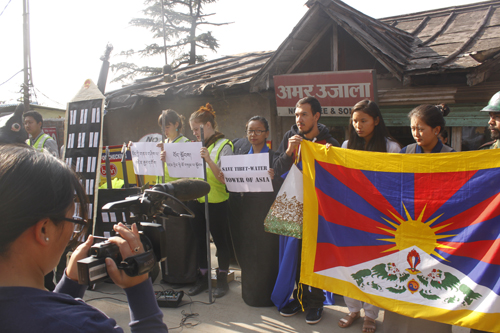Now China is fishing in Nepal’s troubled waters
Srikanth Kondapalli, Daily Mail | November 30, 2015
Since a new Constitution was adopted without considering the aspirations of Madhesis and Janjatis in the Terai region, events in Nepal have given China opportunities to fish in the troubled South Asian waters.
However, the Himalayan barriers are likely to cushion Nepal-India relations for the foreseeable future.
Trouble began in Nepal when it adopted a new Constitution after a tedious process of consultations and political bickering among different political parties.
However, locals in the Terai region are up in arms with their demands for representation. This led to the Madhesis stopping fuel and other supplies from entering Nepal.
Mainstream political parties whipped up an anti-India tirade and sought China’s help.
China quickly moved in with over 1,000 tonnes of petrol for Nepal, in addition to the possibility of exploring other related measures.
However, while China made major in-roads into Nepal recently, it is still not a viable option as structural factors have hamstrung Nepal-China relations.
Influence
First, China began influencing Nepal on Tibet and other issues.
Nepal’s movement towards China includes the former’s adherence to the “one China” policy, where it treats Tibet as an “inalienable” part of China, endorsement of “anti-secession” law on Taiwan and Tibet, and Beijing’s “three evils” construct.
Kathmandu also came under pressure to endorse Beijing’s membership in the SAARC.
Both also began the Sajha Yatayat bus service from 2005.
As a result, it is frequently reported in the local press that China’s paramilitary troops intrude into Nepal to chase the fleeing Tibetans who find the Kodari road convenient to escape from Tibet.
As a result, while over 10,000 Tibetans used to escape to the Kathmandu valley a few years ago, it has now come down to three-digit figures.
Heeding Beijing’s advice, Nepal’s authorities had been putting restrictions on the Tibetan elections by confiscating the ballot boxes.
Second, China’s arms supplies to Nepal, in violation of the 1950 Indo-Nepal Treaty, have drawn Indian ire.
In 1987, Nepal bought $200 million of small arms from China, resulting in the Indian blockade of its borders with Nepal.
However, the current stand-off, according to the Indian side, is due to the blockade of Nepali Madhesis themselves.
Blockade as a coercive policy is not alien to China either. The Mongolian borders were blockaded by China when the Dalai Lama visited Ulan Bator in 2002.
Mongolia, also a land-locked country like Nepal, had been trying in vain to get access to Tianjin port closer to Beijing as a port of entry.
Mongolia also attempted to construct a railway line through Russia into Siberian coasts. However, this is too long and an expensive proposition so far. Nepal has lessons in this episode.
Third, while foreign policy consultations between New Delhi and Beijing commenced after the devastating earthquake in April, this new line appears to be only for buying time.
In recent time, China had initiated a policy of integration with consequences for regional domination.
Transformation
Historically, the fate of the five Himalayan kingdoms – Tibet, Nepal, Sikkim, Ladakh and Bhutan – in the 19th to 20th century, went through a major transformation with the expanding empires of British India and Qing China.
The British Indian authorities once thought of Tibet as a buffer between India and China.
However, today these buffers are going through a painful transformation with the rise of China which had attempted to puncture the Himalayas with its Western Development Campaign and reflected in the Tibet railway construction by 2006.
In its new avatar of Silk Road, China is attempting to link the Tibet railway with Kathmandu, for which an agreement was signed in late 2014.
China’s long-term game plan is to provide aid and assistance to the South Asian countries and create alternate incentives for them against India.
More concrete expressions are over 19 border trading ports being constructed by China on the Tibet-Nepal borders.
Of these, eight are in the advanced stages – such as the ones at Kodari-Nyalam, Rasua-Kerung, Yari (Humla)-Purang, Olangchunggola-RIYO and Kimathanka- Riwo Nechung (Mustang)-Legze.
The dry port at the Nepal-China border of Larcha appears to be more lucrative.
However, with the devastating earthquake in Nepal in April this year, many of these remain inaccessible.
Differences
China also made an audacious initiative in its Lumbini investment of $3 billion, but got stuck in the political differences in Nepal as well as the Indian pressure.
More strategic is the $43 million project of the Chinese telecommunications major ZTE for four data centres in Biratnagar, Kathmandu, Hetauda and Pokhara.
This could provide China access and hold over the strategic communications network in Nepal.
A new element of contest between India and China is emerging in Nepal.
While it is reported in the local press and in interviews that both India and China ‘cultivate’ Nepal’s political leaders, Beijing’s deep pockets and its political influence in Kathmandu seem to be overshadowing Indian influence.
A Nepalese parliament committee, not very long ago, cited financial irregularities by the ruling political dispensation in a Chinese-funded energy project.
So, all in all, while China is making concerted attempts to enter into Nepal, and while the Indian soft power took a beating with rising protests in Kathmandu, it won’t be easy for Beijing to break the historical ‘umbilical cord’ between India and Nepal.
The writer is Professor of Chinese Studies at Jawaharlal Nehru University


